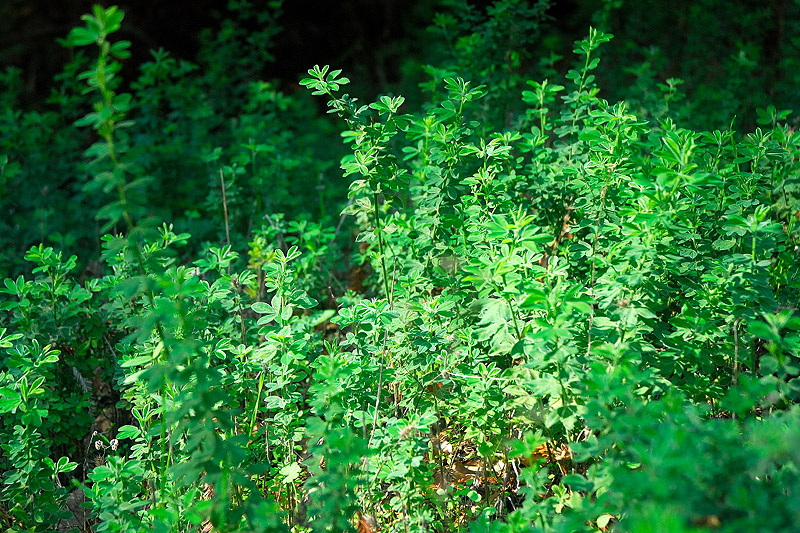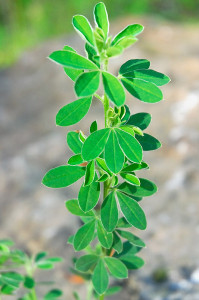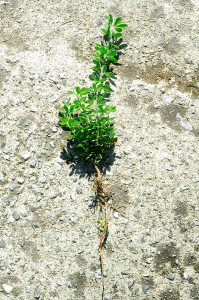
French broom in bloom
French broom (Genista monspessulana), a Mediterranean native similar in appearance to Scotch broom, is right at the top of my list of most loathed plants. French broom was first introduced to California in 1871, escaped cultivation, and was so successful at propagating itself, that it was reported as ‘naturalized’ in this state by the 1940’s. There are some estimates that now suggest French broom occupies more than 100,000 acres of land just in California.
Identification of French broom can be slightly challenging. Scotch, Spanish, and Portuguese brooms are deciduous, but French broom is evergreen. Although similar in appearance to other broom species, French broom is a very leafy plant, and all leaves are trifoliate in structure. Other brooms have simple, or narrow compound leaves, though some have trifoliate leaves, but only on the lower parts of the plant.
Why is French Broom Bad?
In California, French Broom is classified as a noxious invasive species, and you don’t have to look far around here to see why. We have two areas here on the farm that have small infestions of this plant. It loves our Mediterranean climate, and will grow in the poorest sandy soils on our slopes. The plant competes with our native vegetation and where it becomes established, it displaces native flora by forming dense monostands, extripating entire populations of native species that once grew there.
When the seed pods shatter, broom seeds are dispersed explosively up to 3-4 meters from individual plants. A single shrub can produce as many 3,500 pods containing up to 20,000 seeds. Approximately 40% of the newly produced seeds germinate immediately after they are dispersed, and another 25% will germinate the second year. The seeds have an impervious seed coat, enabling some seeds to remain dormant in the soil for up to 50 years, making long-term management very difficult.
Broom infestations degrade the quality of habitat for wildlife by displacing native species, and dense stands can alter microclimate conditions at the soil level. In addition, because brooms are leguminous plants, they are able to fix atmospheric nitrogen, which increases soil fertility and gives a competitive advantage to other non-native weeds that, unlike the local natives, thrive in high nitrogen soils. Large dense thickets can also inhibit the movement of wildlife, including native California quail.
As if all that isn’t enough, the seeds and leaves contain quinolizidine alkaloids, associated with nervous dysfunction, and can be toxic to humans and wildlife. Ingested foliage can cause digestive disorders in horses, and staggering and paralysis in livestock.
French broom also alters nutrient and water cycling, and resprouts readily when cut, grazed, or burned. French broom burns readily, increasing both fire risk, and intensity.
Control Methods
As seeds can remain viable for years in undisturbed soils, and the fact that this plant has become so pervasive in California, we may never be able to entirely eradicate the French broom from our property, but we’re determined to try. Despite our diligent removal of this plant by hand, twice a year we begin again, removing new plants as they emerge. Although brooms usually don’t reach flowering maturity until the second or third year of growth, under the right conditions, including ample moisture, broom species can produce flowers and seeds their first year, making early removal critical to control.
We’re avoiding the use of chemical control methods as our sloping property drains into two creeks. Burning the plants, although capable of clearing large stands, can also encourage new plants to sprout from dormant seeds. That leaves us with mechanical control methods. You guessed it, good old-fashioned elbow grease. The majority of our plants are relatively young, and hand-pulling is relatively easy during late fall and early spring, when soils are damp. However, mechanical methods of removal require persistence.
For mechanical removal of small infestions of larger, more established plants, The California Department of Food and Agriculture (CDFA) recommends The Weed Wrench as “one of the most effective techniques for the complete removal of French broom”. French broom can readily resprout from any remaining rootstock in the soil, but digging out the rootstocks is not recommended, because it can bring dormant seeds to the soil surface, and encourage germination. The Weed Wrench apparently locks on to the base of the stem and you leverage the plant out of the soil to remove the entire plant with minimal soil disturbance. As yet, we have no personal experience with this tool, but are considering purchasing the smaller model for removing some of our larger plants. If anyone has experience with this tool, we would love to hear of your experiences with it.
We realize that pulling plants is only part of the solution however. Each spring and fall we will need to continue to monitor the infested areas of the property, pulling new seedlings as they emerge. To prevent re-establishment of French broom in areas we’ve cleared, we also need to revegetate with fast growing perennial native plants and grasses that can outcompete the French broom, and that’s where we still need to do some homework to determine which plants would be best suited to this site. Clearly, we’re a long way from solving this problem, and we’ll be broom bashing for some time to come.












Hello,
What valuable information. It is a shame what damage invasive plant species can do in a particular area. I hope your efforts continue to minimize these plants on your property.
I found your blog on Blotanical – Welcome!
Thanks Noelle, glad you stopped by! 🙂
Great job guys. Broom is all over the East Bay hills including in our regional parks. I’m glad you’re making an effort to clear your patch of it and to bring the natives back.